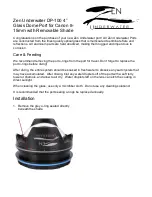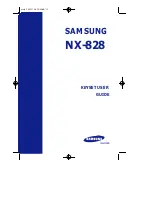
5
Always connect the
BLACK (negative)
wire directly to the battery negative terminal using the crimped
eyelet supplied, as this is the best earth on the bike.
Not using the battery earth/NEGATIVE is the
most likely cause for electrical interference issues
.
Connect the
RED (Positive)
wire to a recommended, switched ignition fused supply
(5 amps
maximum, unless you fit an additional in-line fuse of between 3 and 5 amps).
Ask your bike supplier if
they know of any recommended accessory power points on the bike, or consult your bikes handbook,
but only use this for the positive supply.
Typical places
to find an
ignition switched fused supply
are the
positive feed to the tail lights
,
or
rear brake light switch
. Ask your bike dealer if you are not completely sure. Please note that you
can split the red and black power cable as required and cut them to length but don’t do this until you
make the final installation/connection, remember that you may need to move the system to a better
location to avoid electrical noise after testing, or perhaps someday onto another bike, so leave plenty of
spare power lead neatly coiled up and secured with a tie-wrap so that it can never fall onto the exhaust
or back wheel/chain etc.
Do not connect to the brake light circuit if your bike has ABS braking and/or a
brake light failure warning system
(consult your bike supplier/ manufacturer for approval before
connecting to any ABS brake light circuit or bikes that have CANbus). If connection to the brake light
supply circuit or rear tail light is not recommended, please use some other recommended fused/ignition
switched 12 volt supply. Always solder the positive joint wherever possible as this provides a more
professional and reliable connection. Do not use quick connectors like scotch-locks etc. These are nearly
always unreliable and most bike manufacturers condemn their use, which may also affect the bikes
warranty. You will notice the supplied fitting kit includes items which will assist in installation e.g. tie
wraps, insulation amalgamating tape to cover the soldered positive joint, (again don’t use this for the
pre-install test) a crimp type eyelet for connection to battery negative terminal, Velcro to fix the control
box and if required also speakers into helmet. For added safety and protection the system has reverse
polarity protection, which means that it reduces the risk of damage if you accidentally wire the power
lead the wrong way around, however, the unit will not function unless wired correctly. The system also
has short circuit and thermal overload protection, which means the unit will automatically shut down in
the event of being overloaded e.g. incorrect transceiver used or improper connections.
Ask your dealer about optional Part 2437 which can help solve problems if you suffer from electrical noise.
WARNING
; extreme caution must be used when working with bike batteries, due to the very high
current capacity of the battery, which if shorted; between the battery terminals, or between the battery
positive terminal and ground (the bike frame eetc.) there is a very high risk burns, fire or explosion.
Identify the rider’s headset speaker harness, which has TWO RED mini connectors.
Connect the
rider’s headset
via one of the coiled headset extension leads supplied
to the riders lead on the
main control hub
, also connect the passengers headset via the other coiled extension lead to the
passengers lead on the main control hub.
DO NOT connect either of the boom microphones, or
the rider’s ambient noise sensor (ANS) just yet, or any other audio interface leads to the
main control hub
.
Set the rider and passenger master volume controls FULLY anti-clockwise (to their lowest
levels)
. Set all the other controls on the front panel to their central positions (so that the pointers on
the end of the knobs point to their corresponding pointers on the label).
Start the bike in a well ventilated area
, after checking that no parts will fall off onto a hot exhaust etc.
Hold the rider’s headset speakers firmly and directly over both ear holes (noting the centre of each
speaker is slightly offset in the plastic housings) and listen carefully for any electrical interference
through the speakers. HT (sparkplug/leads and coils etc) may induce a rapid tick, tick, tick noise which
changes with engine RPM. Alternator noise if heard is normally a higher frequency constant whine,
which again changes with engine RPM, so try to vary the engine RPM while listening carefully through
the speakers for any induced electrical noise. It should be completely clean and in which case you can
now turn the rider’s volume control fully clockwise (FULL VOLUME) and do the same test again, it should
be completely clean. Now do the same tests using the passenger headset to again prove it is complete
clear of any electrical interference. It is very unlikely that you will hear any electrical interference while
doing these tests, but if you do you should carefully move the lead/s about, one at a time, and/or the
main control hub unit, while still listening to the speakers with the engine running at varying RPM to
identify which part is picking up the noise and then move it to a clean noise free location.
When you have done this and are happy with the location of the main control hub unit, headset leads
and power leads, you can
switch the engine off
and Velcro the main control hub unit into place, tie-
wrap the headset leads and power lead neatly in place,
double checking to avoid any problems
areas as mentioned in Top Tips (1)
.
When fitting the socket holders to the bike, ensure all surfaces are flat, clean, dry and free from grease
and wax. Note: sockets are designed to tear off if pulled for safety purposes.
We strongly recommend that you test your headsets out of the helmet (before installation)
to make it easier for you to experience how even small movements in microphone and speaker
positioning can considerably reduce or improve the sound quality and ease of use. With this knowledge
you will have a benchmark to work to during final helmet installation later and be sure you are getting
the very best out of your system.
Do not use earplugs during this test as they will hide and/or disguise
much of what we are trying to listen for
.
Avoid pressure directly to the front or back covers of the microphones as this could cause
damage
. The microphone is floating in an acoustically dampening material to help prevent any helmet
vibration being transmitted through the boom to the microphone as part of the noise cancelling
measures. To move or adjust the microphone please hold it by the outer edges or rubber neck, making
sure that the
beige side of the fabric sits flat against and central to your lips
. Try to avoid the
microphone covers touching the Velcro on the back of the speakers.
Turn both the rider and passenger master volume controls fully anti-clockwise (to their lowest volume
settings).
Connect one of the boom microphones to the riders headset loom, noting the red connector
will only connect together if aligned the right way round, making sure that it clicks right in, and do the
same for the riders ambient noise sensor (ANS).
CONNECTING THE POWER LEAD TO THE BIKE
TEST
THE PRE-INSTALLATION
FOR
ANY ELECTRICAL
NOISE
, AND MOVE PARTS IF REQUIRED BEFORE FIXING
UNDERSTANDING THE HEADSETS
BEFORE
HELMET INSTALLATION
Super Pro Auto Instructions 8/5/09 2:24 pm Page 5






































